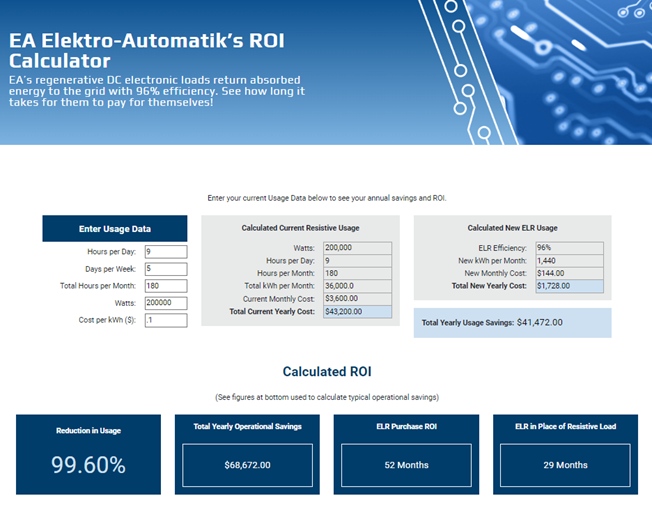Sustainable Testing: Good for the Planet and Good for Your Company
June 16, 2023 | Topics: Battery Test, Sustainable Energy
Thorough testing with appropriate test tolerances to endure product reliability and maximizing test speed to reduce test costs are always the primary goals for manufacturing test engineers. However, another objective has been gaining attention recently; that objective is reducing energy consumption in test systems.
The benefits of reducing energy consumption are twofold – reducing a company’s carbon footprint while at the same time reducing operating costs. Sustainability pledges are often set at the top of a company which becomes the culture, trickling down to the engineers conducting tests and speccing equipment. Just like the end product might be green energy, testing in the lab and on the development floor can also be part of the overall sustainability pledge.
Ready to Get Started? Request a Quote
Trends in sustainable testing in DC programmable power supplies
We conducted a survey recently among users of power supplies. We found that 86% of users identified as design engineers and design managers and 96% of users who identified as manufacturing test engineers and test managers responded that energy savings was moderately important for power supply selection. That is evidence that engineers are paying attention to energy consumption, sustainability and environmental goals.
At EA Elektro-Automatik, we are designing power supplies and electronic loads optimized for efficiency to support corporate and green energy goals. Our PSB series bi-directional DC power supplies and ELR electronic loads use high-efficiency, SiC power transistor-based switch mode design technology with active power correction greater than 0.99 to deliver or absorb DC power at the lowest possible utility cost/Watt.
In addition, both the PSB and ELR instruments employ regenerative circuity and can return absorbed energy to the AC power grid. Both instruments can return greater than 96% of absorbed energy to the grid. That means the instrument consumes only 4% of the energy supplied to it when operating as a load, firmly establishing EA Elektro-Automatik as an industry leader in energy efficiency.
Cost savings in electric vehicle battery testing
One area where energy-saving instrumentation can have a significant impact is electric vehicle (EV) battery testing. The market for EVs is growing at a high compound annual growth rate of greater than 20%. That growth rate requires testing a large quantity of batteries. To ensure proper performance, manufacturers test 100% of EV batteries. These are large batteries with capacities from 30 kWh to 100 kWh. Battery voltages are in the 200 V to 400 V range and trending higher. These batteries need to deliver 50 kW to 300 kW.
Let’s consider an example of the utility cost savings resulting from testing an EV battery as shown in the figure below. We will assume we are testing 10 kW battery packs. We will discharge the battery pack at the rate of 1C, 10 kWh in one hour. The setup will test 8 batteries a day, 5 days a week, for 50 weeks. We will conservatively assume an industrial electric utility rate of $0.10/kWh.
- Total Number of batteries tested/year = 8 hours/day x 5 days/week x 50 weeks/year = 2000 batteries.
- Cost per battery = 10 kWh/battery x $0.10/KWh = $1.00/battery
- Energy cost/year for one instrument = 2000 batteries x $1.00/battery= $2000
- Energy savings/instrument/ year = $2000 x 0.96 returned energy = $1920.

EA PSB and ELR instruments can return greater than 96% of absorbed energy to the grid
That cost-saving amount is a conservative estimate. Discharging batteries at a rate of 2C and adding a second shift will increase manufacturing output by a factor of 4. The resulting cost savings are $7680/year. For higher-power batteries, the savings are even greater.
Also, consider the reduced heat that the high-efficiency regenerative instruments generate compared to conventional instruments that do not have regenerative circuitry. In the example above, the bi-directional power supply and the electronic load consume 10 kWh of energy during each hour of operation. That is equivalent to 36,000,000 J. That is a huge amount of heat. Removing that heat, the heat absorbed by a conventional instrument requires significant cooling infrastructure, which comes at a high cost. The EA PSB and ELR instruments only need to dissipate the 4% of the 36,000,000 J or 1,440,000 J requiring much less cooling equipment capacity at a lower capital cost.
The return on investment is substantial when you consider the total utility cost savings for the instrumentation and the instrument cooling. You can justify the use of PSB or ELR regenerative instrumentation on the financial benefits alone. Furthermore, you can add the justification of meeting corporate goals for reducing energy consumption. That is good for the planet and good for your company.

ROI calculator for regenerative DC electronic loads. Click the image above or right here to see this tool in action.
One of the tools we have created to help engineers understand the cost savings in EA regenerative DC electronic loads is our ROI calculator. The interactive tool allows users to put in their usage data to get their total yearly usage savings. Also, users can look at their ROI for an EA ELR and the ROI for purchasing an EA ELR over a conventional resistive load.
Powering what’s possible
What’s next in sustainability for sustainable testing? For starters, consider the quality of the equipment you use to reduce waste. Investing in top testing equipment will identify potential weaknesses in power supplies before they reach the market, reducing the frequency of replacements.
Next, plan for future testing down the road. What power increases will your products face? What are the testing challenges you have now that might become larger in the future? Getting the right equipment now will sustain you through future growth and reduce repeated upgrades.
Learn more about PSB bi-directional DC power supplies and ELR electronic loads.

